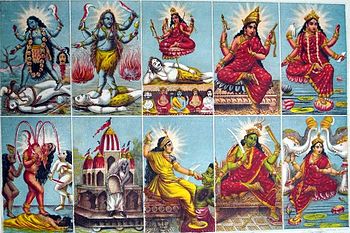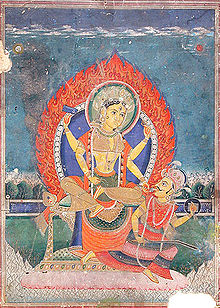- Mahavidya
-
Mahavidyas (Great Wisdoms) or DashaMahavidyas are a group of ten aspects of the Divine Mother or Devi in Hinduism. The Ten Mahavidyas are Wisdom Goddesses, who represent a spectrum of feminine divinity, from horrific goddesses at one end, to the ravishingly beautiful at the other.[1]
The development of Mahvidyas represents an important turning point in the history of Shaktism as it marks the rise of Bhakti aspect in Shaktism, which reached its zenith in 1700 CE. First sprung forth in the post-Puranic age, around 6th century C.E., it was a new theistic movement in which the supreme being was envisioned as female. A fact epitomized by texts like Devi-Bhagavata Purana, especially its last nine chapters (31-40) of the seventh skandha, which are known as the Devi Gita, and soon became central texts of Shaktism.[2]
Contents
Etymology
The name Mahavidyas comes from the Sanskrit roots, with maha meaning 'great' and vidya meaning, 'revelation, manifestation, knowledge, or wisdom.[2]
Names
Shaktas believe, "the one Truth is sensed in ten different facets; the Divine Mother is adored and approached as ten cosmic personalities," the Dasa-Mahavidya ("ten-Mahavidyas").[3] The Mahavidyas are considered Tantric in nature, and are usually identified as:[4]
- Kali: The ultimate form of Brahman, "Devourer of Time" (Supreme Deity of Kalikula systems)
- Tara: The Goddess as Guide and Protector, or Who Saves.Who offers the ultimate knowledge which gives salvation (also known as Neel Saraswati).
- Lalita-Tripurasundari (Shodashi): The Goddess Who is "Beautiful in the Three Worlds" (Supreme Deity of Srikula systems); the "Tantric Parvati" or the "Moksha Mukuta".
- Bhuvaneshvari: The Goddess as World Mother, or Whose Body is the Cosmos
- Bhairavi: The Fierce Goddess
- Chhinnamasta: The Self-Decapitated Goddess
- Dhumavati: The Widow Goddess,or the Goddess of death.
- Bagalamukhi: The Goddess Who Paralyzes Enemies
- Matangi: the Prime Minister of Lalita (in Srikula systems); the "Tantric Saraswati"
- Kamala: The Lotus Goddess; the "Tantric Lakshmi"
The Mahabhagavata Purana and Brhaddharma Purana however, list Shodashi (Sodasi) as Tripura Sundari, her another name.[1] The Guhyatiguyha-tantra associates the Mahavidyas with the ten Avatars of Vishnu, and states that the Mahavidyas are the source from which the avatars of Vishnu arose. All ten forms of the Goddess, whether gentle or terrifying, are worshiped as the universal Mother.
See also
Further reading
- Tantric visions of the Divine Feminine: The Ten Mahāvidyās, by David R. Kinsley. University of California Press, 1997. ISBN 0-520-20499-9. Excerpts
References
- ^ a b Mahavidyas Hindu goddesses: visions of the divine feminine in the Hindu religious tradition, by David R. Kinsley. University of California Press, 1988. ISBN 0-520-06339-2. Page 161-165.
- ^ a b The Devī Gītā: the song of the Goddess, by Cheever Mackenzie Brown. SUNY Press, 1998. ISBN 0-7914-3940-2. Page 23
- ^ Shankarnarayanan, S., The Ten Great Cosmic Powers: Dasa Mahavidyas. Samata Books (Chennai, 1972; 4th ed. 2002)., pp. 4, 5.
- ^ Kinsley, David. Tantric Visions of the Divine Feminine: The Ten Mahavidyas. University of California Press (Berkeley, 1997).
External links
Mahavidya Kali · Tara · Tripura Sundari · Bhuvaneshvari · Bhairavi · Chhinnamasta · Dhumavati · Bagalamukhi · Matangi · Kamalatmika
Hinduism · Hindu goddess · Shaktism · Tantra Hindu deities and texts Gods 
Goddesses Texts Hinduism · Hindu mythology · Indian epic poetry Categories:- Hindu goddesses
- Forms of Parvati
- Mahavidyas
- Sanskrit words and phrases
Wikimedia Foundation. 2010.



